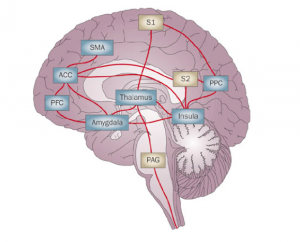We always hear that someone says, “ I can feel your pain” in our daily life. Is it just an expression of sympathy or is it real that people carry other’s pain as if it was their own?
Before I talk about this topic, I’d like to share the recent scientific news first. A new study in rodents suggest that mice feel each other’s pain. “Healthy mice living in the same room with mice experiencing pain are up to 68% more sensitive to pain themselves, regardless of their stress levels, according to the new study, which found that mice could scent when their fellows were suffering.” After the study, the researchers at Oregon Health & Science University in Portland thought that smell might be the massager.
(If you are interested in this study, you can click the following link: Social transfer of pain in mice) Then we can get a conclusion that feeling other’s pain is not only an expression of sympathy but also a real biological phenomenon. Although it is too early to these findings to humans, there is growing evidence that people also share their pain.
Then we go back to the topic.
The way the brain perceives pain
If we would like to understand or explain that we can feel other’s pain, we should know how our brain process pain. Actually the determinants of pain are varies. In 1968, Melzack and Casey studies that the concept of pain as a perception, has sensory, motivational, and cognitive determinants. So when these three factors work, we get the sense of pain that is an adaptive process that is a warning of actual or potential injury.
With the development of brain imaging technique (such as PET or fMRI), cognitive neuroscientists found that different pains can cause some same activations in our brain structure, so called “pain matrix”. Figure 2 outlines the regions that are generally shown to be activated in functional imaging studies of pain. Pain matrix involves the parts that process the cognition of pain like the primary sensory cortex and the parts that trigger the emotional responses of pain like anterior cingulate cortex. It is possible that due to the activity of pain matrix, we can feel other’s pain when we see they are suffered.
structure, so called “pain matrix”. Figure 2 outlines the regions that are generally shown to be activated in functional imaging studies of pain. Pain matrix involves the parts that process the cognition of pain like the primary sensory cortex and the parts that trigger the emotional responses of pain like anterior cingulate cortex. It is possible that due to the activity of pain matrix, we can feel other’s pain when we see they are suffered.
Do we feel pain differently when see other’s pain?
Let’s assume that when seeing other’s pain, we would trigger our pain matrix. So can we distinguish the pain that we actually get by body damaging and the pain from seeing other’s pain? Professor Singer and other researchers in the University of Zurich had a fMRI research in 2004. Volunteers experienced a painful stimulus and compared it to that elicited when they observed a signal indicating that their loved one was receiving a similar pain stimulus.(The specific study is in this link: Empathy for Pain Involves the Affective but not Sensory Components of Pain) Then they conclude that the neural substrate for empathic experience does not involve the entire “pain matrix.” So it is obvious that “self” pain and “other” pain are different, and other’s pain always trigger only the part that cause people have emotional responses of pain in our brain but not the part means that we are actually suffered.
If we just simply conclude by one study, it is largely possible that it has file drawer problem. Then I find another study from Alessio Avenanti in Nature Neuroscience shows that people have an actual physical reaction when observing others being injured or expressing pain. So at least, we can reject the null hypothesis that there is no relationship between self feelings and other’s pain, and accept the alternative hypothesis that people can feel other’s pain.
Why we can feel other’s pain?
Empathy helps us to understand feelings and inner states of mind of others and to share experiences, needs, beliefs and goals. Humans can generally empathize with others and imagine what another person is going through. The reason we have empathy is that we have a system called “synaesthesia for pain” . In synaesthesia for pain a person not only empathy with another’s pain but experiences the observed or imagined pain as if it was their own. Mirror-touch synesthesia is one type of synaesthesia for pain.It is related to the activity of mirror neurons, according to International Encyclopedia of the Social & Behavioral Sciences, which provides a correspondence in the neural activation during the actual execution of an action and the observation of other person’s action and this system is supposed to allow several key social processes, such as understanding other persons’ intentions and behaviors, as well as self-awareness and learning through imitation. So if we observe someone suffering physical pain, the pain is “mirrored” through our sensation. Some people have an unusually strong ability to empathize with others. And children with asperger syndrome are less capable of empathy.
Lastly, there are still many theories about mirror neuron system debated. Scientist cannot get a final conclusion. Hence we need more meta-analysis, peer reviews and researches.
I think mirror-touch synesthesia (if it really exists) help people more considerate about the feelings of others, and more adaptive in the society. Feeling other’s pain is not a bad thing.

The topic of this article was one that I found interesting because of sometimes think I can feel others pain. For example, if I am watching a sports game on television or in person and it is evident that they have suffered a severe injury I feel as though I go into their mindset and can to a degree feel what they are feeling at that time. Additionally I feel if someone has done something embarrassing I can feel their embarrassment to a degree at that time. Here is an article I found from a site called psychology today that explains how we feel the pain of others.
I was extremely attracted to your post due to my lack of empathy, it has always been my greatest flaw. Overall I am just not a very emotional person however the only time i feel the urge to cry is when I see somebody else crying. Is it because deep down inside I feel bad for them or is it just like how yawning is contagious?
https://www.linkedin.com/pulse/why-do-we-cry-when-see-others-crying-neuroscientific-sarah-halabi
This article suggests that our brains have neurons that mimic neurons of the person you are observing. Therefore, if someone tears up you do not have to feel their pain to tear up as well but your brain is just wired to do so.
Dear Luyi,
The first thing that came to my mind when I read your article’s title was the biological miracle of twins; I have often heard that twins are somehow connected in ways that they cannot explain, and weirdly enough, they can sense when the other pair is in danger or in pain. So, I put this claim to the test and found that there is no scientific evidence that supports that twins have some sort of telepathy or ESP, but there are an extraordinary amount of anecdotes that prove otherwise. Although, however, Andrew spoke about how anecdotes cannot be used to form conclusions in science, they definitely help to bring awareness that something is probably going on. If you wan to know more about what it is that that I am alluding to, skim this article where I gathered all my information from:
https://www.verywell.com/twin-telepathy-2447130
Now, regarding my opinions on your article itself, I thought it was a genius organizational idea to split it up into sections with bolded headings to aid the reader in knowing exactly what the text was going to be about. It made it much easier for me to understand. However, I could not help but notice that you did not state a final conclusion on whether people could feel others’ pain; I am wondering if you did this on purpose because there was no concrete evidence to support it…?
Anyways, pretty great article!